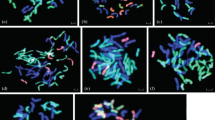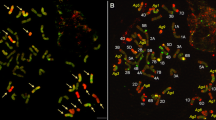Abstract
A total of 240 F1 hybrids was made beween wheat (Triticum aestivum L. em. Thell. (2n = 6x = 42) and T. carthlicum Nevski (2n = 4x = 28)) and perennial lymegrass (North European Leymus arenarius (L.) Hochst. (2n = 8x = 56) and North American L. mollis (Trin.) Pilger (2n = 4x = 28)). The wide crosses yielded embryos in 20% of caryopses and 96% of the embryos developed into normal hybrid plants. The hybrids were vegetatively vigorous, with evidence of the Leymus rhizomatous habit. Those deriving from L. arenarius survived overwintering in Iceland, but the hybrids L. mollis did not, whereas in a milder environment, both showed perenniality. Cytogenetic analysis of root tip cells before the plants were treated with colchicine showed that 21 out of 28 hybrids investigated had chromosome mosaics, with a population of both amphihaploid and amphidiploid cells. This spontaneous doubling of somatic chromosomes occurred in all cross combinations, with the highest average frequency of diploid cells (28%) in T. carthlicum × L. arenarius crosses. A few selfed seeds have been obtained from a T. aestivum × L. arenarius hybrid. All the hybrids were treated twice with colchicine, but the treatment appeared to have little or no effect on the frequency of chromosome doubling in the hybrids deriving from T. aestivum. The frequency of diploid cells, however, increased significantly (e.g. to 80%) in the hybrids deriving from the T. carthlicum parent. Genomic in situ hybridization confirmed the hybridity of the plants and showed that the hybrids were amphiploids containing genomes of both wheat and lymegrass. In situ hybridization using ribosomal DNA probe differentiated chromosomes of L. mollis, L. arenarius from those of wheat. The hybrids are being backcrossed with lymegrass pollen, aiming to domesticate the wild, perennial species.
Similar content being viewed by others
References
Ahokas, H., 1970. Some artificial intergeneric hybrids in the Triticeae. Ann Bot Fennici 7: 182–192.
Ahokas, H., 1992. Endospermal protein diversity, as revealed by electrophoresis and Ig binding on blotted membranes, in Leymus arenarius from non-littoral, roadside niches. Ann Bot Fennici 29: 295–304.
Anamthawat-Jónsson, K. & S.M. Reader, 1995. Pre-annealing of total genomic DNA probes for simultaneous in situ hybridization in cereal species. Genome 38: 814–816.
Anamthawat-Jónsson, K., J. Gudmundsson, B.Th. Bragason, P.K. Martin & R.M.D. Koebner, 1994. Perennial lymegrass (Leymus arenarius and L. mollis) as potential crop species for northern latitudes. In: K.B. Jensen, R.R.-C. Wang & C. Jaussi (Eds), Proc 2nd Int Triticeae Symp, pp 59–64. Utah State University Press, Logan, Utah.
Comeau, A., G. Fedak, S.-A. St-Pierre & C. Thériault, 1985. Intergeneric hybrids between Triticum aestivum and species of Agropyron and Elymus. Cereal Res Commun 13: 149–153.
Dewey, R.D., 1984. The genomic system of classification as a guide to intergeneric hybridization with the perennial Triticeae. In: J.P. Gustafson (Ed.), Proc 16th Stadler Genet Symp, pp. 209–279. Plenum Press, New York.
Dong, Y., Y. Zhouzhou & Z. Ganyuan, 1986. Study on hybridization of Triticum aestivum with Leymus multicaulis and Leymus racemosus. In: Z. Li & M.S. Swaminathan (Eds), Proc 1st Int Symp on Chromosome Engineering in Plants, pp. 185–187. Xian, China.
Fatih, A.M.B., 1983. Analysis of the breeding potential of wheat-Agropyron and wheat-Elymus derivatives. I. Agronomic and quality characteristics. Hereditas 98: 287–295.
Fukuda, K. & S. Sakamoto, 1992. Studies on unreduced gamete formation in hybrids between tetraploid wheats and Aegilops squarrosa L. Hereditas 116: 253–255.
Gale, M.D. & T.E. Miller, 1987. The introduction of alien genetic variation in wheat. In: F.G.H. Lupton (Ed.), Wheat breeding; its scientific basis, pp. 173–210. Chapman & Hall, London, New York.
Gerlach, W.L. & J.R. Bedbrook, 1979. Cloning and chaterization of ribosomal RNA genes from wheat and barley. Nucleic Acids Res 7: 1869–1885.
Greipsson, S. & A.J. Davy, 1994. Germination of Leymus arenarius and its significance for land reclamation in Iceland. Ann Bot 73: 393–401.
Griffin, L.C. & R.M. Rowlett, 1981. A ‘lost’ Viking cereal grain. J Ethnobiol 1: 200–207.
Jiang, J., B. Friebe & B.S. Gill, 1994. Recent advances in alien gene transfer in wheat. Euphytica 73: 199–212.
Klebesadel, L.J., 1985. Beach wildrye. Agroborealis 17: 31–38.
Koba, T. & T. Shimada, 1992. Variations in the crossability of common wheat cultivars with cultivated barley. Hereditas 116: 187–192.
Koebner, R.M.D., P.K. Martin & K. Anamthawat-Jónsson, 1995. Multiple branching stems in a hybrid between bread wheat (Triticum aestivum) and lymegrass Leymus mollis. Can J Bot 73: 1504–1507.
Laurie, D.A. & M.D. Bennett, 1986. Wheat × maize hybridization. Can J Genet Cytol 28: 313–316.
Löve, Á. & D. Löve, 1975. Cytotaxonomical atlas of the Arctic flora, vol. 2. J Cramer, Vaduz, Liechtenstein.
McGuire, P.E. & J. Dvôrák, 1981. High salt-tolerance potential in wheatgrasses. Crop Sci 21: 702–705.
Merker, A., 1992. The Triticeae in cereal breeding. Hereditas 116: 277–280.
Mok, D.W.S. & S.J. Peloquin, 1975. Three mechanisms of 2n pollen formation in diploid potatoes. Can J Genet Cytol 17: 217–225.
Mujeeb-Kazi, A. & R. Rodriguez, 1981. An intergeneric hybrid of Triticum aestivum L. × Elymus giganteus. J Heredity 72: 253–256.
Mujeeb-Kazi, A., M. Bernard, G.T. Bekele & J.L. Miranda, 1983. Incorporation of alien genetic information from Elymus giganteus into Triticum aestivum. In: S. Sakamoto (Ed.), Proc 6th Int Wheat Genet Symp, pp. 223–231. Kyoto.
Mujeeb-Kazi, A., S. Roldan & J.L. Miranda, 1984. Intergeneric hybrids of Triticum aestivum L. with Agropyron and Elymus species. Cereal Res Commun 12: 75–79.
Mukai, Y., T.R. Endo & B.S. Gill, 1991. Physical mapping of the 18S.26S rRNA multigene family in common wheat: Identification of a new locus. Chromosoma 100: 71–78.
O'Donoughue, L.S. & M.D. Bennett, 1994. Durum wheat haploid production using maize wide-crossing. Theor Appl Genet 89: 559–566.
Plourde, A., A. Comeau & C.A. St-Pierre, 1992. Barley yellow dwarf virus resistance in Triticum aestivum × Leymus angustus hybrids. Pl Breeding 108: 97–103.
Plourde, A., A. Comeau, G. Fedak & C.A. St-Pierre, 1989a. Intergeneric hybrids of Triticum aestivum × Leymus multicaulis. Genome 32: 282–287.
Plourde, A., A. Comeau, G. Fedak & C.A. St-Pierre, 1989b. Production and cytogenetics of hybrids of Triticum aestivum × Leymus innovatus. Theor Appl Genet 78: 436–444.
Riley, R. & V. Chapman, 1967. The inheritance in wheat of crossability with rye. Genet Res 9: 259–267.
Schwarzacher, T. & A.R. Leitch, 1994. Enzymatic treatment of plant material to spread chromosomes for in situ hybridization. In: P.G. Isaac (Ed.), Methods in Molecular Biology, vol. 28, pp. 153–160. Humana Press, New Jersey.
Sharma, H.C. & B.S. Gill, 1983a. Current status of wide hybridization in wheat. Euphytica 32: 17–31.
Sharma, H.C. & B.S. Gill, 1983b. New hybrids between Agropyron and wheat. 2. Production, morphology and cytogenetic analysis of F1 hybrids and backcross derivatives. Theor Appl Genet 66: 111–121.
Sigurbjörnsson, B., 1962. Studies on the Icelandic Elymus. PhD thesis, Cornell University, USA.
Snape, J.W., J. de Buyser, Y. Henry & E. Simpson, 1986. A comparison of methods of halpoid production in a cross of wheat, Triticum aestivum. Pl Breeding 96: 320–330.
Tavoletti, S., 1994. Cytological mechanisms of 2n egg formation in a diploid genotype of Medicago sativa subsp. falcata. Euphytica 75: 1–8.
Thomas, J.B., P.J. Kaltsikes & R. Glenn, 1981. Relation between wheat-rye crossability and seed set of common wheat after pollination with other species in the Hordeae. Euphytica 30: 121–127.
Author information
Authors and Affiliations
Rights and permissions
About this article
Cite this article
Anamthawat-Jónsson, K., Bödvarsdóttir, S.K., Bragason, B.T. et al. Wide hybridization between wheat (Triticum L.) and lymegrass (Leymus Hochst.). Euphytica 93, 293–300 (1997). https://doi.org/10.1023/A:1002965322262
Issue Date:
DOI: https://doi.org/10.1023/A:1002965322262




